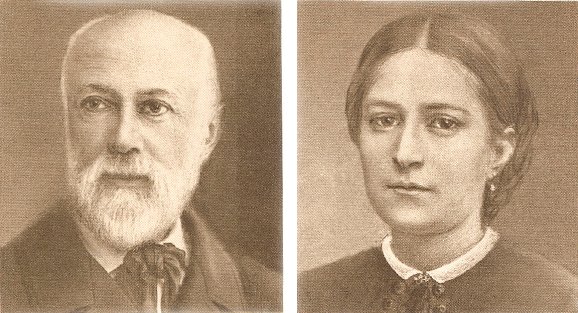Louis Martin (1823-1894) was a successful watchmaker by trade. Born into a family of soldiers, Louis spent his early years at various French military posts. He absorbed the sense of order and discipline that army life stimulates. At 22, young Louis sought to enter religious life at the monastery of the Augustinian Canons of the Great St. Bernard Hospice in the Alps. Unfortunately, the monastery insisted the young candidate learn Latin. His most determined efforts to do so failed. Louis became dispirited, and abandoned his hopes for the monastic life. Eventually he settled down in Alencon and pursued his watchmaking trade.
Zélie Guerin (1831-1877) was one of Alencon’s more talented lace makers. Born into a military family herself, Zélie described her childhood and youth as “dismal.” Her mother and father showed her little affection. As a young lady, she sought unsuccessfully to enter the religious order of the sisters of the Hotel-Dieu. Zélie then learned the Alencon lace-making technique and soon mastered this painstaking craft. Richly talented, creative, eager, and endowed with common sense, she started her own business and became quite successful.
Louis Martin and Zélie Guerin eventually met in Alencon, and on July 13, 1858, Louis, 34, and Zélie, 26, married and began their remarkable voyage through life. Within the next 15 years, Zélie bore nine children, seven girls and two boys. “We lived only for them,” Zélie wrote; “they were all our happiness.”
The Martins’ delight in their children turned to shock and sorrow as tragedy relentlessly and mercilessly stalked their little ones. Within three years, Zélie’s two baby boys, a 5-year-old girl, and a 6-and-a-half-week-old infant girl all died.
Zélie was left numb with sadness. “I haven’t a penny’s worth of courage,” she lamented. But her faith sustained her through these terrible ordeals. In a letter to her sister-in-law, who had lost an infant son, Zélie remembered: “When I closed the eyes of my dear little children and buried them, I felt sorrow through and through … People said to me, ‘It would have been better never to have had them.’ I couldn’t stand such language. My children were not lost forever; life is short and full of miseries, and we shall find our little ones again up above.”
The Martins’ last child was born January 2, 1873. She was weak and frail, and doctors feared for the infant’s life. The family, so used to death, was preparing for yet another blow. Zélie wrote of her 3-month-old girl: “I have no hope of saving her. The poor little thing suffers horribly … It breaks your heart to see her.” But the baby girl proved to be much tougher than anyone realized. She survived the illness. A year later she was a “big baby, browned by the sun.” “The baby,” Zélie noted, “is full of life, giggles a lot, and is sheer joy to everyone.” Death seemed to grant a reprieve to the Martin household. Although suffering had left its mark on mother and father, it was not the scar of bitterness. Louis and Zélie had already found relief and support in their faith
The series of tragedies had intensified the love of Louis and Zélie Martin for each other. They poured out their affection on their five surviving daughters: Marie, 12, Pauline, 11, Leonie 9, Celine, 3, and their newborn. Louis and Zélie named their new-born MarieFrancoise-Therese Martin. A century later, people would know her as St. Therese, and call her the “Little Flower.”
Louis and Zelie fostered an importance of faith in their family. The Martins were the first couple in history to be canonized together on October 18, 2015.
This article originally appeared in Between Friends magazine.

